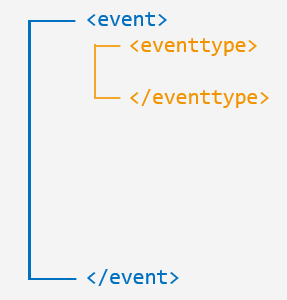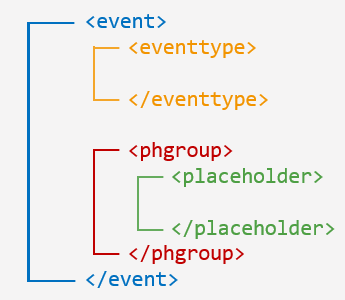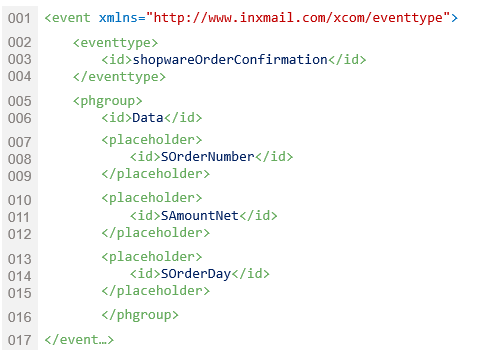The event configuration is carried out using the XML markup language. The XML tags are used in a descriptive function. (Data is exchanged between the source system and Inxmail Commerce via JSON.) Only the placeholders that you enter in the event configuration, within the corresponding XML tags, can be received by Inxmail Commerce and then used in the transactional emails.
There are nine XML tags in total for the event configuration. Below is an explanation of some of the main XML tags.
|
|
|
|
The <event> tag marks the beginning and end of an event. |
|
|
|
|
The <eventtype> tag encloses the event ID. |
|
|
|
|
The <phgroup> tag is used to group placeholders or data. For example, you can group placeholders that relate to the customer or the product. |
|
|
|
|
The <placeholder> tag is used to define the actual placeholders. The placeholders within |
|
|
|
|
|
|
|
Most tags require a |
|
|
|
Example using Shopware
The example shows a simplified event configuration for an order confirmation for Shopware.
Further tags
Other possible tags not shown in this example relate to the language and data type. Therefore, the Integer data type would normally be specified for the SOrderNumer placeholder, the DateTime data type for the SOrderDay placeholder.
Another main tag often used for order and shipping confirmations is <phlist>. Placeholders within a <phlist> tag are displayed as a list within the transactional email. This tag relates specifically to the Article list module in mailings (Creating a mailing – adding modules).
Related topics
Event templates in Inxmail Commerce
For some source systems, templates for standard events are available in Inxmail Commerce, so that you do not have to create the event XML yourself. Here you may only need to modify the corresponding event XML according to your needs.







